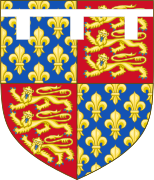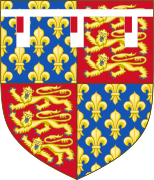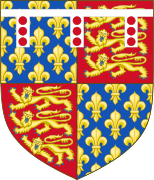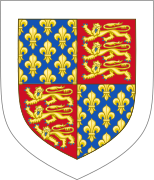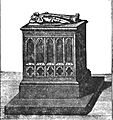Issue of Edward III of England facts for kids
King Edward III of England and his wife, Philippa of Hainault, had many children – eight sons and five daughters! Their family was very important in English history. Later, some of their descendants fought in a big conflict called the Wars of the Roses. This war was about who should be the next king of England.
A scientist named Adam Rutherford once said it's almost impossible for someone with mostly British ancestors not to be related to Edward III. He figured that "almost every Briton" is a descendant of Edward III from 21 to 24 generations ago.
Contents
- Edward III's Sons and the Throne
- Arms of Edward III's Sons
- Edward III's Daughters
- Images for kids
Edward III's Sons and the Throne
The Wars of the Roses were civil wars in England. They were fought between different branches of King Edward III's family. These branches were all descended from his five sons who lived to be adults. Each family group believed they had the best claim to the throne. This was based on things like who was born first, if they were legitimate, or even the gender of their ancestors.
The main royal line, called the Plantagenets, ended when King Richard II died. But before that, his uncle Thomas of Woodstock was executed. The heirs from Lionel of Antwerp were skipped over. Instead, the powerful Henry IV became king. He was a descendant of Edward III through John of Gaunt.
These kings, known as the Lancasters, survived challenges from their cousins, the Edmund of Langley (York) family. But eventually, the Yorks took the throne with Edward IV. Later, fighting among the Yorks left Richard III as king. He was first supported, then betrayed, by his cousin Buckingham. Buckingham was a descendant of Thomas of Woodstock. Finally, the Yorks lost the throne to Henry VII of the House of Tudor. He was another descendant of John of Gaunt. Henry VII married the eldest daughter of the Yorkist King Edward IV, bringing the families together.
Edward, the Black Prince (1330–1376)
Edward, the Black Prince (born 15 June 1330 – died 8 June 1376) was the Duke of Cornwall and Prince of Wales. He was Edward III's oldest son. Sadly, he died before his father, so he never became king.
Edward's only child who lived was Richard II. Richard became king but had no children of his own. Richard II chose his cousin Roger Mortimer, 4th Earl of March as his heir. Roger was the main heir from Lionel of Antwerp's family. However, Richard II was later removed from the throne. Another cousin, Henry Bolingbroke (who became Henry IV), took his place. Henry was the main heir from John of Gaunt's family.
Roger Mortimer actually had a stronger claim to the crown than Henry. But Edward III had changed the rules in 1376, leaving Roger's ancestor Philippa out of the line of succession.
Lionel of Antwerp, Duke of Clarence (1338–1368)
Lionel of Antwerp, 1st Duke of Clarence (born 29 November 1338 – died 7 October 1368) was Edward III's third son. He also died before his father.
Lionel had only one child, a daughter named Philippa. She married into the powerful Mortimer family. This family had a lot of influence during the reigns of Edward II and Edward III. Philippa's son, Roger Mortimer, 4th Earl of March, was chosen by King Richard II as his heir. But Roger died before Richard, leaving his young son Edmund as the next in line.
Later, Anne Mortimer, Edmund Mortimer's oldest sister, married Richard, Earl of Cambridge. Richard was from the House of York. This marriage combined Lionel of Antwerp's family line with the York family line.
John of Gaunt, 1st Duke of Lancaster (1340–1399)
John of Gaunt (born 6 March 1340 – died 3 February 1399) was Edward III's fourth son.
Legitimate Male Heirs (Lancaster)
John of Gaunt married Blanche of Lancaster. Their legitimate male descendants were known as the Lancasters. This line included King Henry IV (1399–1413). He removed his cousin King Richard II from the throne in 1399. Henry IV was followed by his son King Henry V (1413–1422), and then his grandson King Henry VI (1422–1471).
This Lancaster line ended in 1471. King Henry VI's son, Edward of Westminster, Prince of Wales, was killed in battle. Henry VI himself was removed from the throne by his cousin Edward, 4th Duke of York. Edward was a great-grandson of Edmund of Langley (Edward III's fifth son). Edward then ruled as King Edward IV.
Legitimized Male Heirs (Beaufort)
John of Gaunt also had children with Katherine Swynford, who he later married. These children and their descendants were called the Beaufort family. They were made legitimate by Parliament and the Pope after John and Katherine married.
John of Gaunt's great-granddaughter from this family, Margaret Beaufort (1443–1509), was the main legitimate descendant of the Beauforts. She married into the House of Tudor. Her only child was Henry Tudor, Earl of Richmond. In 1485, at the Battle of Bosworth, Henry took the throne from King Richard III. Henry ruled as King Henry VII (1485–1509).
Even though the Beauforts were made legitimate, King Henry IV later added a rule that they could not become king. However, after the Yorkist King Edward IV took the throne from the Lancastrian King Henry VI, the Tudors still claimed they had a right to the throne. King Richard III, the last Yorkist king, was killed at the Battle of Bosworth in 1485.
The current Somerset family, the Dukes of Beaufort, are direct male descendants of John of Gaunt. They are from an illegitimate line of Henry Beaufort, 3rd Duke of Somerset. They use "Somerset" as their family name.
Edmund of Langley, 1st Duke of York (1341–1402)
Edmund of Langley, 1st Duke of York (born 5 June 1341 – died 1 August 1402) was Edward III's fifth son. His descendants were known as the Yorks.
He had two sons. One was Edward of Norwich, 2nd Duke of York, who died fighting with Henry V. The other was Richard of Conisburgh, 3rd Earl of Cambridge. Richard was executed for treason because he was part of a plan to put his cousin, Edmund Mortimer, 5th Earl of March, on the throne.
As mentioned before, Richard had married Anne de Mortimer. This marriage gave their son (and the House of York) a stronger claim to the throne through Lionel of Antwerp's line. This claim was considered better than that of the House of Lancaster (who came from a younger son than Lionel) and the House of Tudor (whose ancestors were barred from the throne). In 1460, Richard, 3rd Duke of York, claimed the throne based on this. An agreement was made that he would become the heir. However, he was killed later that year, and his son Edward took over the claim.
Thomas of Woodstock, Duke of Gloucester (1355–1397)
Thomas of Woodstock, 1st Duke of Gloucester (born 7 January 1355 – died 8 or 9 September 1397) was Edward III's eighth son. He was an important figure under Richard II. He was later killed, likely on Richard II's orders, for treason. His main heir was his daughter Anne, who married into the Stafford family. Their heirs became the Dukes of Buckingham. Henry Stafford, 2nd Duke of Buckingham, was descended from Thomas of Woodstock on his father's side.
Arms of Edward III's Sons

- Arms of the sons of Edward III
-
Peace Shield of the Black Prince: A black shield with three white feathers. This is now the symbol of the Prince of Wales's feathers.
-
Arms of Henry IV (1399–1413), John of Gaunt's oldest legitimate son: The Royal arms of England.
Edward III's Daughters
- Isabella, Countess of Bedford (born 16 June 1332 – died around 5 October 1382). She married Enguerrand VII de Coucy, the 1st Earl of Bedford. They had children.
- Joan of England (born February 1334 – died 2 September 1348). She died from the plague in Bordeaux while on her way to marry Peter of Castile. She had no children.
- Blanche (born 1342). She died when she was very young.
- Mary of Waltham (born 10 October 1344 – died September 1362). She married John IV, Duke of Brittany. She had no children.
- Margaret, Countess of Pembroke (born 20 July 1346 – died October/December 1361). She married John Hastings, 2nd Earl of Pembroke. She had no children.
Images for kids


